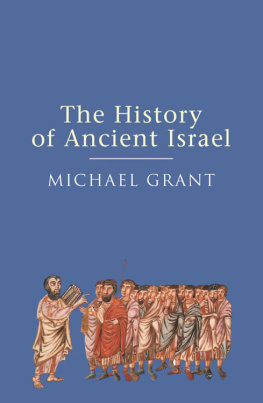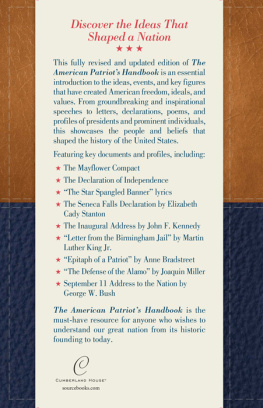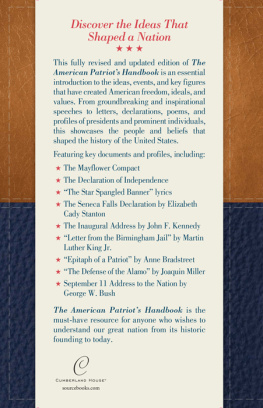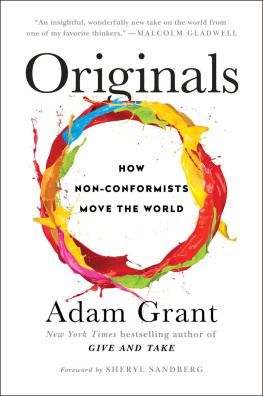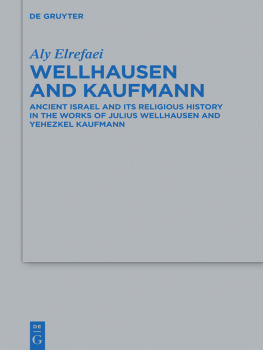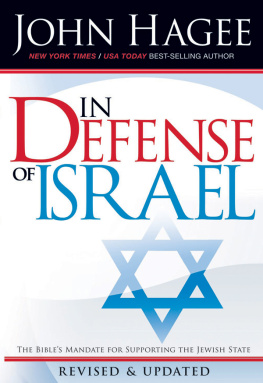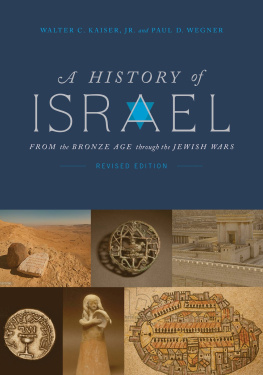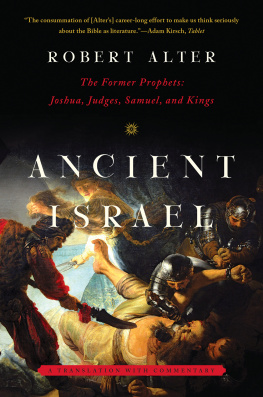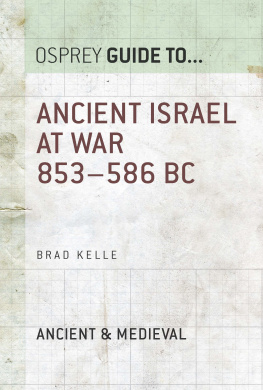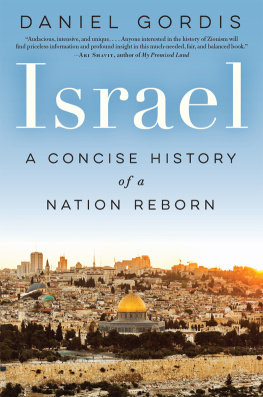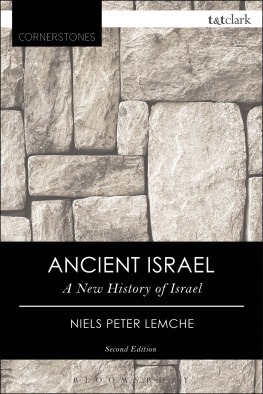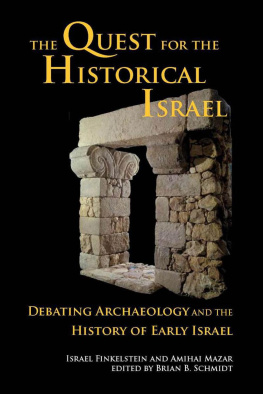Grant - The History of Ancient Israel
Here you can read online Grant - The History of Ancient Israel full text of the book (entire story) in english for free. Download pdf and epub, get meaning, cover and reviews about this ebook. year: 2012, publisher: Weidenfeld & Nicolson, genre: Religion. Description of the work, (preface) as well as reviews are available. Best literature library LitArk.com created for fans of good reading and offers a wide selection of genres:
Romance novel
Science fiction
Adventure
Detective
Science
History
Home and family
Prose
Art
Politics
Computer
Non-fiction
Religion
Business
Children
Humor
Choose a favorite category and find really read worthwhile books. Enjoy immersion in the world of imagination, feel the emotions of the characters or learn something new for yourself, make an fascinating discovery.
The History of Ancient Israel: summary, description and annotation
We offer to read an annotation, description, summary or preface (depends on what the author of the book "The History of Ancient Israel" wrote himself). If you haven't found the necessary information about the book — write in the comments, we will try to find it.
The definitve guide to the history of ancient Israel.
The History of Ancient Israel covers the epic story of Jewish civilisation from its beginnings to the destruction of Jerusalem, and the Temple in AD 70. It deals with Israels relations with the great empires which shaped its development and with the changing internal structure of the Jewish state, drawing both on excavation and the Hebrew Bible.
**
The History of Ancient Israel — read online for free the complete book (whole text) full work
Below is the text of the book, divided by pages. System saving the place of the last page read, allows you to conveniently read the book "The History of Ancient Israel" online for free, without having to search again every time where you left off. Put a bookmark, and you can go to the page where you finished reading at any time.
Font size:
Interval:
Bookmark:
Michael Grant (19142004) was a highly successful and renowned historian of the ancient world. He held many academic posts including those of Fellow of Trinity College, Cambridge; Professor of Humanity at Edinburgh University; Vice Chancellor of The Queen's University, Belfast and Vice Chancellor of the University of Khartoum. He was a Doctor of Letters at Dublin and a Doctor of Laws at Belfast. He has also been President of the Classical Association of England, the Virgil Society and the Royal Numismatic Society, and was a Medallist of the American Numismatic Society.
of Ancient Israel
MICHAEL GRANT

This is an account of ancient Israel, extending from its beginnings to the destruction of Jerusalem and the Temple in AD 70.
Part of the tale is told by excavations, which reveal many aspects of the material culture and everyday life of those times, but by far the most significant evidence is provided by the Hebrew Bible, the Old Testament of the Christians. This unparalleled compilation, which has inspired the literature and art and ethics of half the world, includes a great deal of historical writing, almost the first that the world had ever seen.
But the purpose of the men who composed the Bible was not just to write a history. Their aim was to depict the glory of Yahweh, and to display his unceasing intervention in human affairs. This aim is of primary historical as well as religious importance because it guided the course which history took. That is to say, the ancient Israelites or Hebrews or Jews accepted the validity of this divine assessment of their destiny, and were conscious of it whatever actions they performed, so that their whole story adopted a shape it would not otherwise have possessed. However, the biblical writers, while rarely ceasing to emphasize this divine guidance, also allowed an enormous amount of straight history to slip through political and social as well as spiritual and intellectual since all these various fields were seen as forming a single, indistinguishable unity. Thus the Bible is an overwhelmingly important source of information. Indeed, for the greater part of the period it is virtually the only source of information we possess, other than the discoveries of archaeologists.
The Bible, of course, is an enormously voluminous, massively varied compendium of anonymous books, which constitutes an entire literature in itself. And it presents the historian with a formidable and perplexing problem, because of the composite, multiple authorship, editorship and conflation that almost every one of these writings, upon investigation, is found to reflect. The number of people in the world today who are intimately familiar with all this material is smaller than it was. I make no apology therefore (except to the cognizant minority) for including summaries of certain of the biblical narratives in the chapters which follow. I do, however, have another and more serious apology to offer. Any claim, on my part, to be capable of deploying all, or most, of the modern methods of textual, literary and historical criticism that are needed for this undertaking would be rash and unwarrantable. All that I can offer, with diffidence, is one mans view of the historical situations which the Hebrew Bible, the Old Testament, illuminates.
I have tried to describe these situations as objectively as possible. This, of course, is an aim which cannot be fully attained, since every writer, however much he hopes to take a balanced view, inevitably employs procedures of selection, arrangement and interpretation which are conditioned, often unconsciously, by his or her environment and background and epoch. Nevertheless, I have endeavoured, as well as I can, to apply the techniques of a historian to the story of the ancient Israelites. Whether the supernatural interventions, in which they believed, actually took place, is not, in my opinion, for the student of history to say: an attempt to recreate the course of events and development of thought is most likely to succeed if its author, for the time being, endeavours to forget whether he himself is a Jew, Christian, Moslem, Buddhist, Hindu, agnostic or atheist if, that is to say, he avoids presuppositions or conclusions based upon his own beliefs or disbeliefs.
Since this book is intended to present a general picture, it will not concentrate on any single theme to the exclusion of others. Yet one persistent theme does seem to emerge. This is the perpetual coexistence and confrontation, among the people of the Bible, of two diverse and apparently opposed points of view concerning foreigners. That is to say, Israel unceasingly harboured the simultaneous convictions, first, that it was an entirely unique and separate community, and, secondly, that it was a nation necessarily linked with other peoples as well, both outside its borders and within them. Israel had to be apart from the world and yet remain inside it, at one and the same time. Modern historians, noting this polarization, have either seen it as a hopeless dilemma between two contradictory opposites, or, instead, as the coexistence of two complementary, indissociable viewpoints which Judaism successfully harmonized and united. Let the argument continue. In any case, these two recurring approaches, whether compatible or contradictory, were both alike essential features of this nations peculiar character and greatness.
And both features are still very prominent in Israel today. I did not write this book with any intention of updating its contents to provide analogies with modern times, but the analogies are there, all the same. Modern Israel is only comprehensible in the light of how its inhabitants acted, and what happened to them, throughout all the centuries of the past, and particularly throughout the ancient world. Those dramatically veering fortunes and vicissitudes including repeated, almost incredible survivals in the face of crushing obstacles will form the subject of the chapters that follow.
This book would scarcely have been possible without Mayor Teddy Kolleks generous invitation to Jerusalem, for which I am extremely grateful. I hope he and others will be indulgent to many failings. I also owe particular appreciation to Miss Linden Lawson of Messrs Weidenfeld and Nicolson for her careful editing of the text a task which, since new materials and interpretations continually came to light, required exemplary patience. I want to thank Father Gregory Bainbridge for offering many perceptive comments, and Mr Patrick Leeson for making the maps. For my wifes advice and help any acknowledgement is entirely inadequate.
Translations: I have for the most part employed translations, for which I am grateful, from the New English Bible ( 1970 by permission of Oxford and Cambridge University Presses), and the Bible in Todays English Version (Good News Bible, O.T. and 4th ed. of N.T., 1976, American Bible Society; British edition published by the Bible Societies/Collins). At times, however, it has seemed preferable to retain the cadences of the Authorized or King James Version (1611; a somewhat modernized version has now appeared). The Jewish Publication Society of America has completed its revised translation (1962-82).
Gattaiola, 1983 Michael Grant
Dates in this book, until , are BC (BCE) unless otherwise stated.
A traveller moving in from the stiff, stormy line of the Mediterranean coast found the land stretching ahead of him in four successive strips. First came the coastal plains of Philistia and Sharon (less fertile then than they have been made now), terminated at the north by the promontory of Mount Carmel. Further inland, beyond the lowland moors of the She-phelah, rose the central rugged plateau (about the size of Kent or Long Island), dotted with unwelcoming thorns and scrub, seamed and broken by steep and narrow gorges, and occupied in historical times, from south to north, by the tribes of Judah, Ephraim and Manasseh (these last two forming the core of Samaria): northwards again was the lands most important inland plain Jezreel (Esdraelon), flanked by Mounts Carmel and Gilboa and merging, on its northern side, into the slopes of Galilee. To the east, the country fell sharply into the Jordan Valley, which widened, at two points, into the Dead (or Salt) Sea and the Sea of Galilee (Lake of Chinnereth, Gennesaret). And finally, to the east, came the hilly or mountainous fringe tracts, not regarded, for millennia, as genuinely Israelite: Edom beyond Judahs Negeb wilderness, and Moab and Ammon across the Jordan.
Font size:
Interval:
Bookmark:
Similar books «The History of Ancient Israel»
Look at similar books to The History of Ancient Israel. We have selected literature similar in name and meaning in the hope of providing readers with more options to find new, interesting, not yet read works.
Discussion, reviews of the book The History of Ancient Israel and just readers' own opinions. Leave your comments, write what you think about the work, its meaning or the main characters. Specify what exactly you liked and what you didn't like, and why you think so.

